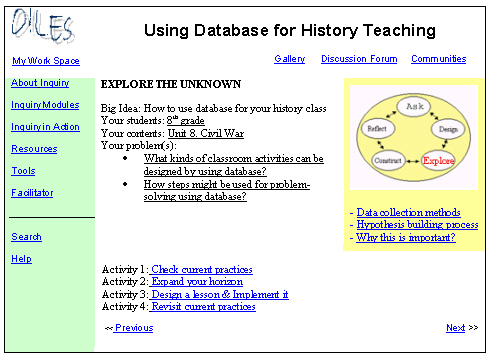Design Guidelines
Expert Review
Home > Design Guidelines > 2. Inquiry Module >2.3. Design of the "Explore" phase
2.3A Provide meaningful tasks or processes in order to engage learners in doing a systematic investigation. Avoid using step-by-step activities. A learning-by design activity might be a good example. It includes designing a lesson plan, an inquiry module, and a web site.
2.3B Clearly communicate that learners are expected to provide multiple solutions and to cope with messiness. Multiple solutions are not easily developed by individuals. Therefore, let the learners share their solution with others and give feedback to each other. For example, provide a structure such as the "Critical friend" method. Pair them or make a team to work together and give feedback to each other.
2.3C Organize and sequence activities in a meaningful way. Use a spiral sequencing. As shown in the example below, the activities are sequenced in a spiral way. Learners check their current practices, expand their perspectives by seeing others' examples and reading some articles, and revisit their practices. During the process, learners are required to develop a lesson plan using database and to implement it (or get an expert review).
2.3D Avoid too many complex processes and make them manageable. Instead of one big process, provide several manageable processes. For each process, provide an interactive writing place (e.g., provide an electronic notebook) and require learners to submit their answers, reviews, artifacts, and so on. · Provide learners with necessary scaffolding to help their exploration. As shown in the example below, learners can use a search engine, resources, tools, facilitators, peers, and refer to other modules and examples. The guidelines will be described in the nurturing environment part.
Example (Screen shot)
Comment: byunlim@indiana.edu
Copyright, 2001: Byung-Ro Lim

